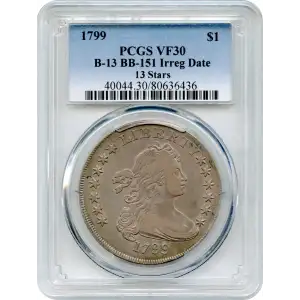
- 630-280-7300
- Free shipping over $4,500
The 1798 Draped Bust dollar, struck at the Philadelphia Mint, introduced two reverse designs: the rare Small Eagle, with an estimated 35,000 minted, and the Heraldic Eagle, part of a 327,536 mintage for 1798, continuing through 1803. The obverse features Liberty facing right, with "LIBERTY" above, the date below, and typically 13 stars (7 left, 6 right), though varieties like the 1799 with 8 left and 5 right exist. The Small Eagle reverse depicts an eagle on a cloud within an open wreath, surrounded by "UNITED STATES OF AMERICA." The Heraldic Eagle, adapted from the Great Seal, shows a left-facing eagle with outstretched wings, a shield on its breast, "E PLURIBUS UNUM" on a ribbon in its beak, three arrows in its right claw, and an olive branch in its left, with 13 stars in arcs or a cross pattern above and clouds forming an arc, encircled by "UNITED STATES OF AMERICA." Both types have a lettered edge: "HUNDRED CENTS ONE DOLLAR OR UNIT."
The Small Eagle type is extremely rare, with few surviving above Very Fine, and Mint State coins are scarce, often showing mint-caused adjustment marks and light strikes due to utilitarian production. The Heraldic Eagle, while more common, is still challenging in higher grades, with Extremely Fine pieces scarce and AU or better rare; with Mint State examples prohibitively expensive. Many 1798 dollars were melted or exported to China for circulation or silver demand, contributing to their scarcity. This, combined with declining domestic demand and exchanges for heavier Spanish or Mexican dollars, led to the suspension of silver dollar production in 1804, not resuming until 1840 with the Liberty Seated design.
